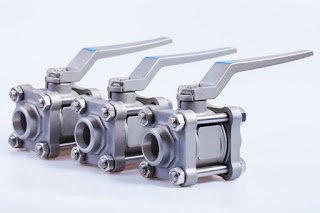 |
| Industrial Application Ball Valves |
In the realm of
industrial process control valves, your selections for most applications are vast. Every application will likely have one or more elements become critical and deciding factors for valve selection. That element might be complex and highly technical, being intimately related to physical or dynamic properties few understand. Conversely, the selection may hinge upon something as obvious as what will fit in the space that is provided. Whatever the case, some efficiency can be brought to bear in your selection process by initially deciding which type of valve would best suit the application. This allows you to focus on a much smaller universe of product candidates for your project.
Like most valves, ball valves are characterized by their closure mechanism. Generally, a ball valve has a spherically shaped fabrication (ball) that is inserted in the fluid flow path. The ball has an opening through its center, often circular in cross section and matching the diameter and shape of the connected pipe. The ball is contained within the body of the valve and rotated around its central axis by torque applied to the stem. The stem, which extends through a seal to the exterior of the valve body, can be manually or automatically controlled via several methods.
During valve operation, the ball is rotated through a ninety degree arc from a fully closed to fully open position. When fully closed, the opening in the ball faces the sidewalls of the valve body and is cut off from the fluid by seals that secure the ball in place and prevent fluid flow around the ball. As the valve stem is rotated toward the open position, the cross sectional area of the opening is increasingly exposed to the fluid flow path until the open area through the ball is aligned with the flow path in the fully open position.
Consider some of these main points and see if a ball valve might be a good selection for your application.
In the plus column:
 |
| Large Ball Valve in a Gas Pipeline |
- When closed this valve type provides a tight closure. When open fully,there is very low resistance to flow.
- Suitable for applications requiring only fully closed or open control.
- With only 90 degrees of rotational motion from open to closed positions, ball valves can provide rapid response to a change in position requirement or command.
- Ball valves are comparatively compact, without the space requirement for extending stem movement as required by some other valve types.
- Ball valves are available in a wide range of construction materials for the body, stem, ball, and seals, making them suitable for a wide range of fluid types and temperatures.
- Force required to rotate to valve stem is moderate, keeping actuator options high and energy requirements low.
- A full size port provides for very low pressure drop across the valve when fully open.
- Requirements for maintenance are generally low. No lubrication required.
In the other column:
- Ball valves are not well suited for throttling applications. Partially open valves expose the seals to the effects of the flow velocity, with possible premature seal deterioration.
- A closed valve can trap residual amounts of fluid in the port (the opening through the ball). This fluid will be released to the valve outlet when the valve is opened.
- Elastomeric materials are often used for the valve seals. Evaluate whether the seal materials are compatible with the fluid characteristics and operating temperature.
There are special adaptations of ball valves which may overcome some of the concerns you have about their application on your project. It is always a good idea to consult with a
valve specialist and consider their recommendations for your project.


